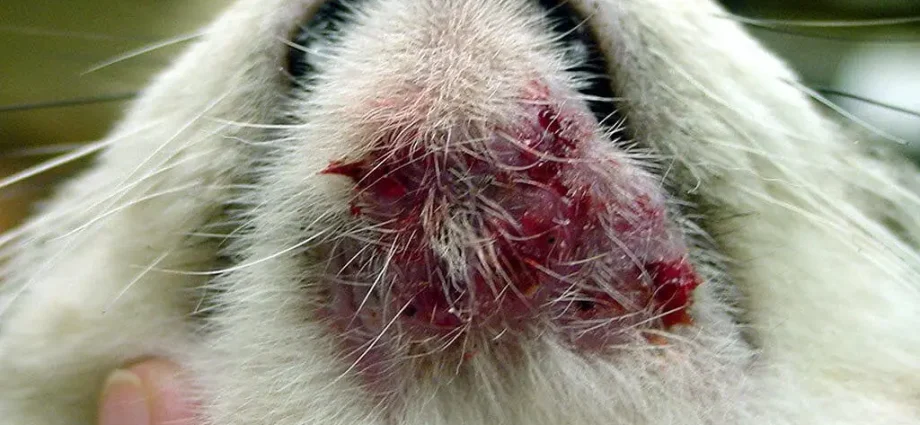Contents
Cat acne, how to treat it?
Cat acne, or feline acne, is a skin disease characterized by the presence of blackheads (or comedones) on the chin and around the lips. It can be found in all cats regardless of their age, breed or sex. It is necessary to consult your veterinarian to initiate treatment as soon as possible.
What is cat acne?
Cat acne is a dermatosis, which is a skin disease characterized by the presence of lesions called comedones. These are small black buttons. The term cat acne therefore refers to the acne that we encounter in humans even if it is not very well suited to cats because it is not exactly the same thing.
This disease results from a keratinization disorder. The sebaceous glands which produce sebum, a substance essential for the protection and hydration of the skin, are the structures affected during feline acne. In cats, these sebaceous glands also contain pheromones which will be deposited during facial marking. Associated with the hair follicles (the place where the hair is born), these glands will undergo inflammation. They will then produce sebum in large quantities which will accumulate and clog the hair follicles, thus forming comedones. Their black color results from the oxidation of sebum, like the flesh of a fruit which turns black on contact with ambient air.
What are the causes of acne in cats?
The origins of this disease remain poorly understood but it seems that stress, certain viruses, a lack of hygiene, an allergy or even an immune disease could be involved by promoting inflammation of the sebaceous glands. In addition, there are no predispositions according to the age, breed or sex of the cat.
Symptoms of cat acne
As cat acne impairs the proper functioning of the sebaceous glands, the affected areas are those where these glands are present in large quantities. Thus, we can observe lesions of the skin mainly on the chin or even around the lips (mainly the lower lip). The following lesions are observed:
- Presence of comedones: these are blackheads;
- Papules: more often called “pimples”, they result from inflammation;
- Crusts;
- Affected area of red color (erythema);
- Alopecia (hair loss) on the affected area.
It should be noted that this disease can be painful and itchy (the cat is scratching). Sometimes the cat can even scratch itself until it bleeds. In addition, secondary infections can occur. In a case of superinfection, pustules or even boils (deep infection of the hair follicle) can occur. In addition, complications can occur, in particular an edema of the chin (swelling) or a swelling of the regional nodes.
Cat acne treatment
As soon as your cat has dermatological lesions such as those described above, it is advisable to make an appointment with your veterinarian to determine the cause of these lesions and to treat it. The latter will examine your cat and carry out additional examinations to confirm or not a feline acne and to exclude any other dermatological damage which presents similar lesions.
Then, a mowing of the affected area and a cleaning will be carried out to disinfect the chin and facilitate the application of the treatment thereafter. The chin being a delicate area, your cat can be tranquilized beforehand. Then, it is generally a local treatment which will be prescribed to you (disinfectant, lotion, shampoo, anti-inflammatory or even antibiotic according to the lesions). For the most serious forms, general treatment may be considered.
Cat acne prevention
Some cats may only have one episode of acne in their entire life while it may be recurrent in others. Many cats are also never affected by this disease. To avoid its appearance as much as possible or to avoid a recurrence, it is necessary to avoid anything that could cause inflammation of the chin. Thus, good hygiene is advised. It is important to thoroughly clean your pet’s food and water bowls on a daily basis. You can also clean his chin after drinking or feeding if he is used to getting dirty.
In addition, it seems that plastic bowls play a role in the appearance of cat acne. Indeed, bacteria can lodge there easily and reach the chin when the cat drinks its water or eats its food by affixing itself to it. In addition, some cats can have an allergy to plastic. Thus, it is recommended to use ceramic bowls or bowls for water and food in order to avoid any danger.
Finally, as stress is one of the factors that can promote the appearance of acne in cats, if your cat is regularly stressed, you can consider investing in soothing pheromone diffusers to limit his anxiety.
In any case, if you have the slightest doubt, do not hesitate to consult your veterinarian. Treatment as early as possible is the best, especially since this disease can be very painful for cats.










